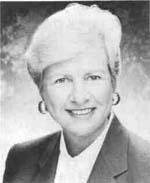|

|
COMPTROLLER'S CORNER
ILLINOIS' RETURN ON THE
GAMING DOLLAR
By Loleta A. Didrickson, Comptroller, State of Illinois
|
Gaming has become a multi-billion dollar business
here in Illinois and it continues to grow at a dramatic
pace. With the addition of riverboat gambling, the
amount of money wagered has exploded over the last
five years from $2.8 billion in 1990 to approximately $18
billion in 1995.
Net state gambling revenues (revenues minus prizes
paid out) grew from $61 million in fiscal year 1974 to
$971 million in fiscal 1995. This increase is due largely to
the lottery and the growing riverboat industry. Horse
racing, bingo and other forms of gambling have not
shown as much revenue growth.
In calendar year 1994, gambling wagers of more
than $17.8 billion came from horse racing, riverboats
and the Lottery (fiscal year 1994). Of the $17.8 billion,
net receipts to the state totalled $736 million or 5.2% of
total wagers.
Specifically, receipts from the Lottery (fiscal year
1994) were $547 million accounting for 36.6% of the
nearly $1.5 billion wagered. Horse racing receipts (calendar year 1994) of $42 million out of a total of more
than $1.2 billion accounted for 3.4%. Receipts from riverboat (calendar year 1994) wagers of $147 million
equalled 1.3% of $11.4 billion wagered.
The return on a gambling dollar of 36.6% to the state
is clearly superior at the state government run Lottery
with the privately run and state-regulated industries of
horse racing and riverboat gambling returning 3.4% and
1.3% respectively.
Comparing the return on the dollar for a public
versus private gambling industry is like comparing apples and oranges. Yet it is possible to directly compare
horse racing and riverboat gambling. If riverboats
would have returned 3.4% of each gambling dollar to the
state as horse racing did, an additional $245 million
could have been received.
Conversely, if horse racing were only required to
turn over 1.3% of their total, $26 million would be retained by a struggling industry. And the state treasury
would be the loser.
Although most of the money generated for the state
comes from wagering dollars, the state also gains from
licensing, fees and registration. The Lottery raises a
small amount this way while riverboats pull in millions
each year. Horse racing revenues are generated by the
privilege tax, breakage, inter-track wagering tax, uncashed pari-mutual tickets, admission tax, licenses and
fines.
The newest form of gambling, riverboats, generate
revenues by a 20% wagering tax, a $2 admission tax and a
license and fee structure for owners, suppliers and employees of riverboats. The licensing and fee costs include everything from $50,000 for an owner's application to cover background checks to individual employee license application fees of up to $1,000. Once a
license is approved, owners pay a $35,000 fee for the
first three years and $5,000 for subsequent years.
Illinois is not the only state experiencing gambling
fever. In a recent report, the U.S. Casino Entertainment
Industry stated that it generated $153 in revenues for
each American household in 1994. This represents an
increase of 26% over 1993. •
February 1996 / Illinois Municipal Review / Page 11
|